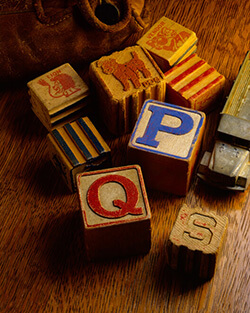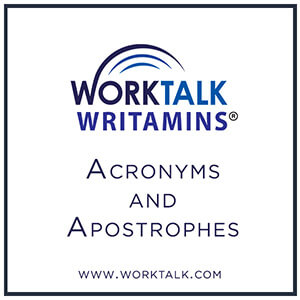[4-minute read]

Several Writamins readers have asked me how to use apostrophes with acronyms.
An acronym is a word made up of the initial first letters of a group of words. For example, NATO, OPEC, and other pronounceable first initials are acronyms. Initialisms are words that are made up of the initials of core words; they differ from acronyms in that the letters themselves are pronounced, as in UPS or CIA.
Acronyms, initialisms, and single letters and numbers pose problems for many writers, perhaps because these terms are not quite words but not quite something else, either. Writers who are confident when dealing with a noun like Pat go all to pieces when faced with PTA. Largely, they feel unsure because they do not know where or even whether to use an apostrophe.
What Do Apostrophes Do?
Apostrophes show possession and contraction.
It is John’s house.
It isn’t so much what he said as how he said it.
Apostrophes do not form plurals.
One car, two cars
One manager, two managers
Note that in the term the ’90s, the apostrophe shows the omission of the number 19. The ’90s are a span of ten years. So there is never an occasion to write the 90’s or the 60’s to represent a decade.
So far, so good.
When to Use Apostrophes with Acronyms, Letters, or Numbers
We do not generally use apostrophes to form plurals of acronyms, initialisms, letters, and numbers, just as we do not use an apostrophe to form the plural of any noun.
She learned her ABCs at school.
She is in her 30s.
All those ICBMs must have cost a lot of money.
We do use an apostrophe to show possession of an acronym or initialism.
The UK’s exit from the EU is called Brexit.
NATO’s policies seem to be working.
The NSA’s eavesdropping policy has me worried.
Do we EVER use an apostrophe to form the plural of an acronym?
I’m going to give the classic consultant’s answer to this question: It depends.
Some style guides say it is all right to say,
She learned her ABC’s at school.
Others say you will burn in a horrible afterlife if you ever use an apostrophe to form a plural. Personally, I side with the folks who say that every time you use an apostrophe to form a plural, a puppy dies.
However, the ultimate arbiter of this question needs to be, as always, the reader.
Have Mercy on the Awkward Plural
If the reader might be confused without the apostrophe before an acronym or initialism, then use the apostrophe. For example, plurals of individual letters and numbers may seem odd without an apostrophe. Some people call these “awkward plurals.”
He dotted all his i’s and crossed all his t’s.
This would be confusing if you wrote, “He dotted all his is and crossed all his ts.”
Mind your ps and qs rattles the brain, while Mind your p’s and q’s sails right into comprehension.
Find all the 7’s on this page may be easier to parse than Find all the 7s on this page.
Awkward plurals, like awkward people, need a helping hand to make themselves understood. For cases when the plural without the apostrophe will make the reader stutter and reread, dive in and use the apostrophe to form a plural. Just don’t tell anybody I said so.
Resources
A blog from the APA Style Guide takes a stern approach.
Another article on this topic from Grammar Monster
Wondering about other tough plurals? Read this article.
See recent Writamins:
Get to the Point.

©2021 Elizabeth Danziger All rights reserved
Take me to your leader! Communication woes drain the lifeblood from an organization. Connect me with your decision-makers and see how Worktalk can transform communication in your world. Contact me at lizd@worktalk.com or 310.396.8303. You can also book through www.calendly.com/worktalk.
